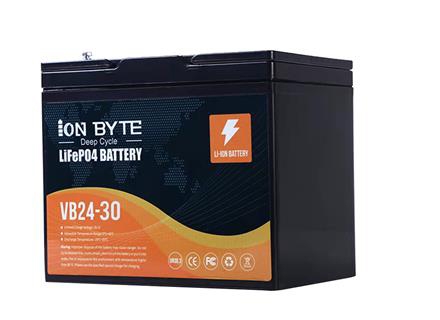
Deep cycle batteries play a vital role in numerous applications, including marine vessels, recreational vehicles (RVs), solar energy systems, and backup power solutions. Unlike standard car batteries, which are designed for short, high-energy bursts to start engines, deep cycle batteries are engineered to deliver consistent power over extended periods. This makes them ideal for applications requiring sustained energy output. To maximize the performance and lifespan of your equipment, it's essential to understand the distinctions between deep cycle and starter batteries, the different types available, their maintenance needs, and how to select the right one for your specific requirements. This guide will provide you with all the necessary information to make informed decisions and optimize your investment.
Starter batteries are akin to sprinters in the battery world. They are built to deliver a high burst of energy in a short time, primarily to start engines, which then rely on fuel for operation. These batteries, commonly found in cars, are not designed for deep discharges, as doing so can significantly reduce their lifespan and performance. Once the engine starts, the alternator takes over to recharge the battery.
In contrast, deep cycle batteries are the marathon runners of the battery world. They are designed to provide a steady, lower level of power over a prolonged period, making them perfect for applications like powering electronics on boats, RVs, or renewable energy systems. For those seeking a battery that combines both starting power and sustained energy output, dual-purpose batteries are an excellent option. These versatile units, such as RELiON's HP series of lithium batteries, offer both high cranking power for starting and reliable auxiliary power for continuous use.
While starter batteries suffer from deep discharges, deep cycle batteries are specifically designed to handle them. The extent to which a deep cycle battery can be safely discharged varies by type. For instance, some lead-acid batteries can only be discharged to 50% of their capacity without damage, whereas certain lithium batteries can be discharged up to 100% without adverse effects. Always refer to the manufacturer's guidelines to determine the safe discharge limits for your specific battery.
Deep cycle batteries are indispensable in scenarios requiring long-term, consistent power. Some typical applications include:
- Electric vehicles like golf carts, scooters, and forklifts
- Mobility aids such as electric wheelchairs
- Marine equipment, including trolling motors and navigational devices
- Renewable energy systems, such as solar power storage
- Industrial equipment like floor cleaning machines and scissor lifts
- Recreational vehicles (RVs) for powering appliances and electronics
Deep cycle batteries come in several varieties, each with its own advantages and disadvantages. The primary types include:
1. Flooded Lead-Acid (FLA) Batteries
These are the oldest type of deep cycle batteries, featuring a liquid electrolyte made of water and sulfuric acid. They require regular maintenance, including adding water and cleaning acid residue. FLA batteries must remain upright and need proper ventilation to release hydrogen gas produced during charging. Despite their affordability, their high maintenance and weight have led to a decline in popularity.
2. Valve Regulated Lead-Acid (VRLA) Batteries – Gel and AGM
Gel and AGM batteries are advanced versions of lead-acid batteries. They use a gelled electrolyte or an electrolyte absorbed in glass mats, eliminating the need for adding water. These batteries are spill-proof, require less maintenance, and can be installed in various orientations. However, they are more expensive and may not last as long as lithium batteries in demanding applications.
3. Lithium-Ion Batteries
Lithium lifepo4 batteries represent the future of deep cycle technology. They are lightweight, maintenance-free, and capable of deep discharges without compromising lifespan. Additionally, they charge faster and perform better in extreme temperatures compared to lead-acid batteries. Although their upfront cost is higher, their longevity and efficiency often make them more cost-effective in the long run.
The capacity and lifespan of deep cycle batteries vary significantly based on their chemistry. Lithium batteries, for example, can deliver up to 100% of their rated capacity regardless of the discharge rate, whereas lead-acid batteries provide less usable energy at higher discharge rates. In cold weather, lithium batteries also outperform lead-acid ones, with only a 10% capacity loss at 0°C compared to a 50% loss in lead-acid batteries.
Lifespan is influenced by factors such as maintenance, charging practices, and environmental conditions. Lead-acid batteries are more susceptible to damage from improper watering, overcharging, or undercharging. In contrast, lithium batteries are more resilient and often come with built-in battery management systems (BMS) to protect against such issues. On average, lithium iron phosphate batteries can last up to 10 times longer than lead-acid batteries.
Selecting the appropriate deep cycle battery depends on your specific needs, budget, and application. Consider factors such as capacity, discharge depth, maintenance requirements, and environmental conditions. If you're unsure which battery is best for your situation, consult with a professional to ensure you make the right choice.
By understanding the nuances of deep cycle batteries, you can optimize their performance and longevity, ensuring reliable power for your applications. Whether you're powering a boat, an RV, or a renewable energy system, the right deep cycle battery will make all the difference.
Next:BYD successfully offlined 60Ah all-solid-state battery
Previous:How to Safely Jump-Start Your Generator with a Car Battery ?
Contact Person: Miss. Elsa Liu
| WhatsApp : | +8617763274209 |
|---|---|
| Skype : | +8617763274209 |
| WeChat : | 17763274209 |
| Email : | Elsa@lifepo4-battery.com |